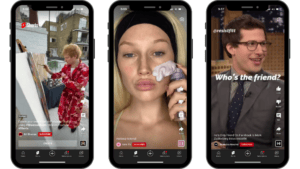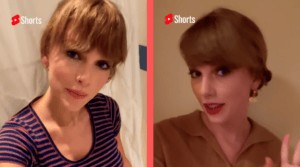The Rise of YouTube Shorts
To begin it was TikTok, then Instagram and Facebook reels, and then just as recently last year, YouTube globally debuted its own Shorts content platform. Like its competitors, YouTube content creators now had a tailor-made short-form video platform. The easy-to-use creative tools, massive audio library, and intuitive user interface has seen Shorts skyrocket in popularity amid a real push from YouTube to highlight the benefits that short-form content can bring.
Given the rise in popularity of short-form video, the emergence of YouTube Shorts is hardly surprising. Since 2005, YouTube as a platform has continually built its success around popular content consumption trends. It’s why a platform that was predominantly known for mindless user cat videos in its early years has maintained relevancy with users, influencers and even celebrities 17 years later. While platform changes and developments have sometimes seemed slow to take off – just look to the launch of YouTube Premium (formerly YouTube Red) that attempted to replicate the success of streaming services – YouTube Shorts has seen a meteoric rise in popularity with now around 15 billion views daily.
For creators this represents an unprecedented shift in demand, raising the question of just why Shorts has become so successful and how sustainable is this short-form content strategy for the platform in its long term future?

Long-form vs short-form content
It only takes a quick browse on social media to see that short-form content, as a form of user-generated media consumption, has grown massively in the past 5-10 years. Unlike long-form videos that might be produced with production values or a script, the limited video lengths and production in Shorts creates a platform suited to useful, personalised, and relatable content. Another distinct benefit for creators is that shorter content is far quicker and simpler to produce. As such, shorts can be easily created to reflect new trends and audience interests with an immediacy less realistic for short-form videos. It is with this easy accessibility for both users and creators that so many short video content creators have been able to become fully-fledged influencers.

Like TikTok, the YouTube Shorts interface is highly intuitive. Users can easily swipe after one short to load another, and the content of new shorts are driven by those previously viewed. It is with this interest-tailored algorithm that viewers of short-form content can easily watch 10+ shorts and stay on a platform longer than if they were watching a standard YouTube video. Such an infrastructure also makes the process of discovering new creators with commonalities far simpler for the user, removing the potential barrier to consumption for casual users of the platform. When coupling this simplicity appeal with shorter attention spans driven by an oversaturation of digital media, it’s no surprise that YouTube Shorts have echoed TikTok and become so popular.
Why YouTube Shorts
Simply attributing the rise in YouTube Shorts to the comparative success of TikTok is not an entirely true argument. Shorts were undoubtedly created to capitalise on upon the success of short-form media, TikTok is a platform built specifically for this type of content. YouTube on the other hand has an established brand and has already figured out video content like long-form videos, live streaming, trending content, stories, and more.
Considering the versatility of the YouTube platform, the unique benefits of Shorts become clearer. While YouTube themselves have stated that shorts have no direct impact on the recommendation of long-form content, indirect capacity for Shorts to drive organic traffic is extensive. This is thanks to its infrastructure that focuses on user tailored content discovery. For long-form platform creators, the use of Shorts can be seen as an organic marketing tool of sorts; a method of driving new users and traffic to their channel. Shorts driven Interest can subsequently be built into a more consistent user following through the main YouTube video content.
For instance, a YouTube creator who uploads long-form videos twice a week has noticed that their analytics are not improving. By utilising the Shorts platform they can draw in new users through engaging and valuable content containing a link to a larger video. For users with an interest in the user generated content, this in effect promises more of the same within the long-form content. Unlike TikTok, shorts can also be scheduled through YouTube Studio to be posted at specific times. This similarly has incentivised the use and rise of shorts as creators can schedule a shorts release to promote new videos, or post in line with the highest traffic use.
Investment and Monetisation
It’s true that YouTube have invested plenty of time and money into a multiplatform and celebrity driven campaign to promote its Shorts service to creators and users alike.

Case in point, the YouTube Shorts Fund.
This has seen YouTube set aside £100 million to invest into their Shorts creators that produce high performing content channel. To be part of the program creators are incentivised to produce useful, innovative and user-friendly content that can therefore generate new users to the platform. While this continued investment has undoubtedly proven to be a key factor in the rise in popularity of Shorts, it represents the monetization dilemma on YouTube.
Despite its popularity, making money through shorts is more difficult and is not sustainable in its current format. While many will be dependent on qualifying for the YouTube Shorts fund, the massive number of users and limited cash investment will only go so far. Another method to make money is through regular YouTube videos that have been driven by the organic traffic generated by a creators shorts; while this can be more sustainable, YouTube take a massive 55% cut of the generated revenue. The only other method of monetization is a reliance upon brand sponsorships which can potentially be unstainable and unless a popular creator, does not represent a consistent revenue stream.
With YouTube Shorts still in its early years its potential advertising formats are still being tested and are constantly adapting; the platform has already announced its plans to trial specific shorts based advertising revenue next year.
However, with a current high reliance on company investment, it’s difficult for anyone to predict the financially viability of the Shorts programme and if the popularity of short-form content will plateau.

The long-term future of shorts
With Shorts rising to have over 2 billion active monthly users in just the span of a year, it would be difficult to say YouTube’s short-form content platform has been anything other than a success. In addition to satiating consumer demand for digestible short content, the platform also provides great incentive for creators to utilise as part of an organic channel growth strategy.
While competitor platforms like TikTok will continue to grow further, YouTube Shorts presents users with a recognisable option without the same privacy concerns surrounding the platform when compared to the Byte Dance owned company.
Despite this, Shorts is still very much in its infancy.
The platform is still missing a dedicated Shorts app, and only recently has a specific Shorts tab been added to YouTube.
Its content discovery algorithms are also continually updated to further improve user experience and maximise the consumption time on the platform. While the current rise of the platform has proved itself a clear winner, the uncertain monetization, continual updates, and alternating trends of social media, predicting the long-term future of Shorts will continue to be a long-term prospect.

